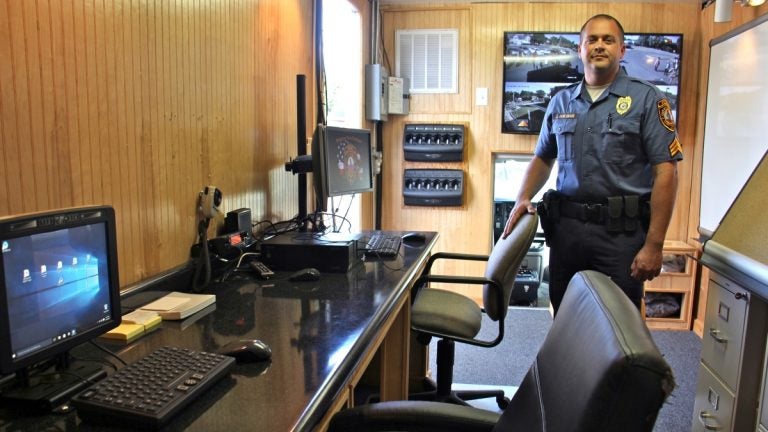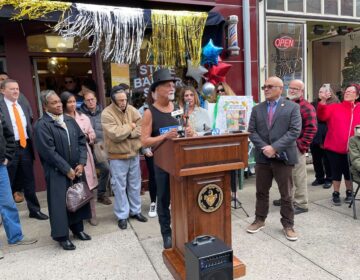How this South Jersey town is fighting a whack-a-mole of crime ‘hot spots’
When a city's crime rates goes up, it doesn't increase equally across all parts of town.
Listen 0:00
Bridgeton Police Sgt. Jason Hovermann mans a mobile police substation the town will use to target troubled areas and improve community policing (Emma Lee/WHYY)
When a city’s crime rates goes up, it doesn’t increase equally across all parts of town.
In policing, the term for this phenomenon is a “hot spot,” a specific area that has seen a recent rash of crime, usually violent offenses.
In Bridgeton, an urban outpost of 25,000 residents surrounded by verdant South Jersey farmland, gun crime is up and hot spots appear and disappear quickly.
Local officials say fighting the problem has been like playing a game of whack-a-mole. They would send police resources to stamp out crime in one “hot spot” just as another would pop up across town. “Bad guys move,” said Mayor Albert Kelly.
On Tuesday, Bridgeton government and law enforcement officials literally rolled out their solution to the problem: a technologically-outfitted box truck that will function as a police substation on wheels.
Inside the truck are two computers officers can use to file reports or access the department’s records management system. The mobile unit is also outfitted with a police radio, a corkboard and two dry-erase boards, and a television screen showing the live feeds of four cameras mounted on the truck’s exterior. Outside, it has high-intensity spot and flood lights.

Sgt. Jason Hovermann said parking the truck in a certain neighborhood is like erecting a mini-precinct there, which officers can use as a temporary base of operations.
“It allows us to stay in that area, come back to [the truck], be able to do any type of reports we need to do,” Hovermann said. “Coming all the way back to the police station removes the officer completely out of his area.”
Although Bridgeton had at least one substation as recently as the early 2000s, now it only has one main police station located at the southern end of town.
Bridgeton is not the first city to deploy a mobile police substation, but officials said it was the most tactically sensible and cost-effective way to deal with rising crime rates.
From January through August, major crime was down across New Jersey compared to the same period last year, according to state data. The reverse was true in Bridgeton, which saw an uptick in major crimes, specifically shootings and armed robberies. The city has had four murders this year.
“There’s been a lot of instances here where I’ve been woken up at night by a: Bang bang. Bang bang bang. There’s gunshots all over,” said Bob Koenige, a 35-year resident who lives just a few blocks from the main police station. “We’re living in a high-crime-rate area here. And it’s not a very good place to live anymore.”
Money is tight in Bridgeton, too. A third of residents live below the poverty line. The police department, a 67-officer force with limited resources, hopes the mobile unit will act as a crime-fighting tool without forcing the city to fork over the money to build a brick-and-mortar substation — which would be especially useless if no “hot spots” existed nearby.
The mobile substation, a hand-me-down from the city’s fire department that cost less than $3,000 to retrofit, has a secondary purpose. Officials said they want the truck to become a nexus for community engagement with the police department, a throwback to the precinct-house model used less often by modern law enforcement agencies with slimmer budgets.
“It localized policing,” said Bill McKnight, a Stockton University professor and a former captain in the Atlantic City police department, which at one point had precinct houses or substations across the city. “Citizens got to know the police officers. There was a local place that they could go to if they had a question or a complaint.”
In fact, for all its tactical gadgetry, the Bridgeton mobile police substation has the feel of a municipal office, with faux-leather chairs and wall-to-wall carpeting. Police Chief Michael Gaimari hopes to outfit the truck with informational material for residents and, once the weather gets warmer, use the mobile substation to further the city’s community policing efforts.
“We can go into a neighborhood, go down to one of the housing complexes, throw open the back, and talk to some of the residents there,” he said.
Gaimari even wants to put a doorbell on the truck for residents hoping to chat with the cops inside.
“It gives the community a chance to interact with the officers in a positive way instead of only interacting with them when we’re on a call and it’s a bad situation.”
WHYY is your source for fact-based, in-depth journalism and information. As a nonprofit organization, we rely on financial support from readers like you. Please give today.



